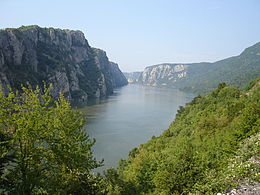Iron Gates
From Wikipedia, the free encyclopedia
This article is about the Danube gorge. For the pass in the Bibans mountains in Algeria, see Iron Gates (Algeria). For other uses, see Iron Gate.
| This article includes a list of references, related reading or external links, but its sources remain unclear because it lacks inline citations. (February 2011) (Learn how and when to remove this template message) |
The gorge lies between Romania to the north and Serbia to the south. At this point, the river separates the southern Carpathian Mountains from the northwestern foothills of the Balkan Mountains. The Romanian side of the gorge constitutes the Iron Gates natural park, whereas the Serbian part constitutes the Đerdap national park.

No comments:
Post a Comment